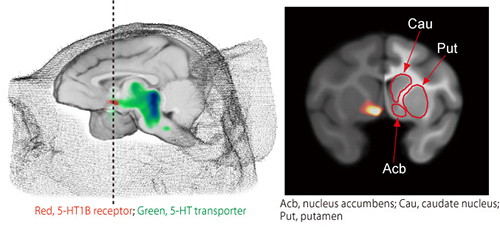Jan. 8, 2014 Press Release Biology Medicine / Disease
Ketamine acts as antidepressant by boosting serotonin
PET molecular imaging of macaque brain reveals that ketamine may act as an antidepressant by boosting serotonin activity in brain areas involved in motivation.
Ketamine is a potent anesthetic employed in human and veterinary medicine, and sometimes used illegally as a recreational drug. The drug is also a promising candidate for the fast treatment of depression in patients who do not respond to other medications. New research from the RIKEN Center for Life Science Technologies in Japan demonstrates using PET imaging studies on macaque monkeys that ketamine increases the activity of serotoninergic neurons in the brain areas regulating motivation. The researchers conclude that ketamine’s action on serotonin, often called the “feel-good neurotransmitter”, may explain its antidepressant action in humans.
The study, published today in the journal Translational Psychiatrydemonstrates that Positron Emission Tomography (PET) molecular imaging studies may be useful in the diagnosis of major depressive disorder in humans, as well as the development of new antidepressants.
Ketamine has recently been shown to have an antidepressant action with short onset and long-term duration in patients suffering from treatment-resistant major depressive disorder, who do not respond to standard medications such as serotonin reuptake inhibitors, monoamine oxidase inhibitors and tricyclic antidepressants. However, the mechanisms underlying ketamine’s action on the depressive brain have remained unclear.
To understand the effects of ketamine on the serotonergic system in the brain, Dr. Hajime Yamanaka and Dr. Hirotaka Onoe, who has pioneered PET imaging on conscious non-human primates, together with an international team, performed a PET study on rhesus monkeys.
The team performed PET imaging studies on four rhesus monkeys with two tracer molecules related to serotonin (5-HT) that bind highly selectively to the serotonin 1B receptor 5-HT1B and the serotonin transporter SERT.
From the analysis of the 3 dimensional images generated by the PET scans, the researchers could infer that ketamine induces an increase in the binding of serotonin to its receptor 5-HT1B in the nucleus accumbens and the ventral pallidum, but a decrease in binding to its transporter SERT in these brain regions. The nucleus accumbens and the ventral pallidum are brain regions associated with motivation and both have been shown to be involved in depression.
In addition, the researchers demonstrate that treatment with NBQX, a drug known to block the anti-depressive effect of ketamine in rodents by selectively blocking the glutamate AMPA receptor, cancels the action of ketamine on 5-HT1B but not on SERT binding.
Taken together, these findings indicate that ketamine may act as an antidepressant by increasing the expression of postsynaptic 5-HT1B receptors, and that this process is mediated by the glutamate AMPA receptor.
Reference
- Hajime Yamanaka, Chihiro Yokoyama, Hiroshi Mizuma, Sachi Kurai, Sjoerd J Finnema, Christer Halldin, Hisashi Doi, and Hirotaka Onoe. "A possible mechanism of the nucleus accumbens and ventral pallidum 5-HT1B receptors underlying the antidepressant action of ketamine: a PET study with macaques". Translational Psychiatry, 2014
Contact
Hirotaka Onoe
Bio-function Imaging Team
RIKEN Center for Life Science Technologies
Jens Wilkinson
RIKEN Global Relations and Research Coordination Office
Tel: +81-(0)48-462-1225 / Fax: +81-(0)48-463-3687
Email: pr@riken.jp

PET scans of monkey brains showing the distribution of the 5-HT1B receptor and transporter in the nucleus accumbens and ventral pallidum.
